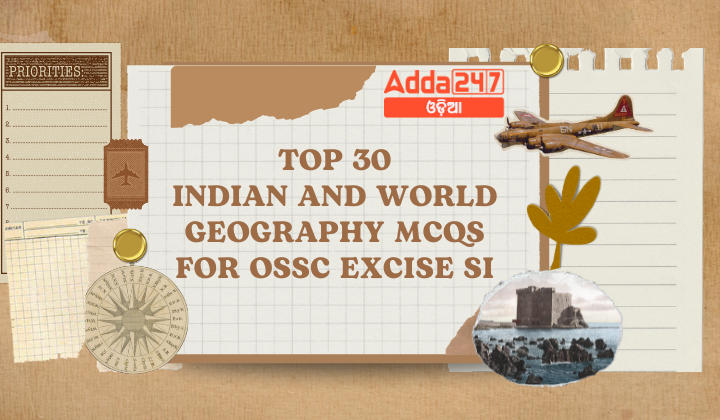Geography plays a crucial role in various competitive examinations, including the OSSC (Odisha Staff Selection Commission) Excise Sub-Inspector (SI) exam. A strong grasp of both Indian and world geography is essential for excelling in this exam. To aid aspirants in their preparation, here is a curated list of the top 30 multiple-choice questions (MCQs) covering Indian and world geography.
Top 30 Indian and World Geography MCQs for OSSC Excise SI
- Which among the following lakes makes the border tripoint of Kenya, Tanzania & Uganda?
A) Lake Turkana
B) Lake Victoria
C) Lake Tivu
D) Lake Tanganyika
Correct Answer: B [Lake Victoria] - What is the number of Galilean moons of Jupiter discovered by Galileo Galilei in January 1610?
A) 2
B) 3
C) 4
D) 5
Correct Answer: C [4] - What is the amount of Iron in Earth (percentage in total mass)?
A) 24.5%
B) 34.6%
C) 39.3%
D) 42.4%
Correct Answer: B [34.6%] - During which of the following events is the distance between the Sun and Earth maximum?
A) Aphelion
B) Perihelion
C) Summer Solstice
D) Winter Solstice
Correct Answer: A [Aphelion] - Which among the following is the most important character of the ‘Goldilocks Zone ‘ of space?
A) It is a small region which is extremely hot and the presence of most elements in vapor state
B) It is a small region of space which is extremely cold
C) It is a region of space which is neither too hot nor too cold and has conditions which are a must for life
D) It is a region of space which is characterized by a lot of asteroids
Correct Answer: C [It is a region of space which is neither too hot nor too cold and has conditions which are a must for life] - Hagia Sophia is located in which country?
A) Germany
B) France
C) Turkey
D) Russia
Correct Answer: C [Turkey] - Which among the following Isthmuses has been known as “The Devil’s Neck”?
A) Kra Isthmus
B) Isthmus of Panama
C) Karelian Isthmus
D) Isthmus of Corinth
Correct Answer: A [Kra Isthmus] - Which of the following is the reason due to which the weight of an object at the poles is greater than at the equator?
A) It is because of the shape of the earth
B) The attraction of the moon is maximum at the earth’s surface
C) The attraction of the sun is maximum at the earth’s surface
D) Gravitational pull is more at the poles
Correct Answer: D [Gravitational pull is more at the poles] - Which of the following is the name given to the common currency for the members of the Common Market in Europe?
A) Dollar
B) Eurodollar
C) Franc
D) Pound
Correct Answer: B [Eurodollar] - Isthmus of Panama is located between which two water bodies?
A) Bay of Bengal and Indian Ocean
B) South China Sea and Pacific Ocean
C) Caribbean Sea and Pacific Ocean
D) Indian Ocean and Arabian Sea
Correct Answer: C [Caribbean Sea and Pacific Ocean] - How many total numbers of gulfs are there in the world?
A) 65
B) 61
C) 72
D) 62
Correct Answer: D [62] - Which is the world’s longest glacier in non-polar regions?
A) Biafo Glacier
B) Hispar Glacier
C) Siachen Glacier
D) Fedchenko Glacier
Correct Answer: D [Fedchenko Glacier] - Colca Canyon is located in which country?
A) Peru
B) Arizona
C) Namibia
D) France
Correct Answer: A [Peru] - The White Dwarf is characterized by which of the following?
A) Low luminosity and low temperature
B) Low luminosity and high temperature
C) High luminosity and high temperature
D) High luminosity and Low temperature
Correct Answer: B [Low luminosity and high temperature] - Who proposed the term dwarf planet?
A) F. Hoyle
B) Alan Stern
C) Galileo
D) Copernicus
Correct Answer: B [Alan Stern] - Which of the following natural vegetation refers to a plant community which has grown naturally without human aid and has been left undisturbed by humans for a long time?
A. Endemic vegetation
B. Virgin vegetation
C. Natural vegetation
D. Desert vegetation
Ans: B - Consider the following statement(s) related to laterite soil:
I. It is formed due to intense leaching.
II. They are fully equipped with organic matter.
Which of the statements given above is/are correct?
A. Only I
B. Only II
C. Both I and II
D. Neither I nor II
Ans: C - Which of the following soils have the attributes of cracks and shrinks in dry conditions?
A. Black clay soil
B. Red porous soil
C. Sandy soil
D. Loamy soil
Ans: A - Which of the following soils is related to the term Regur?
A. Laterite Soil
B. Black Cotton Soil
C. Red Soil
D. Deltaic Alluvial Soil
Ans: B - What is the reason for the red color of the red soil?
A. Phosphoric Acid
B. Humus
C. Nitrogen
D. Iron
Ans: D - Consider the following statement(s) related to Regur soils or Black cotton soils.
I. It is formed by solidification of lava spread over a large area of the Deccan plateau.
II. They are very rich in mineral contents because these soils were formed due to volcanic activities.
III. They are found in Karnataka, Maharashtra, MP, Gujarat, AP, and Tamil Nadu.
Which of the above statement(s) is/are correct?
A. Only I
B. Only II
C. Both I and II
D. I, II, III
Ans: D - Which of the following soils has air space and is loosely packed?
A. Sandy Soil
B. Clayey Soil
C. Loamy Soil
D. All of these
Ans: A - Which of the following is/are examples of chemical weathering?
I. Frost action on rocks.
II. Repeated wetting and drying.
III. Oxidation of minerals in a rock
Which of the statements given above is/are correct?
A. I and II only
B. I and III only
C. III only
D. I, II, and III
Ans: C - Which of the following comes under the phenomena of mass movement?
I. Soil creep
II. Weathering
III. Landslide
Which of the statements given above is/are correct?
A. Both I & II
B. Both I & III
C. Both II & III
D. I, II, and III
Ans: B - Consider the following statement(s) related to alluvial soils.
I. The soil covers 40 percent part of the total geographical area of India.
II. Alluvial soils are formed due to depositional work done by rivers in plains, valleys, floodplains, and deltas.
Which of the above statement(s) is/are correct?
A. Only I
B. Only II
C. Both I and II
D. Neither I nor II
Ans: C - Which of the following statements is/are related to natural vegetation?
I. Natural Vegetation follows climatic variables and grows naturally.
II. Natural vegetation varies according to the climate, soil, and altitude.
Which of the following statement(s) is/are correct?
A. I only
B. II only
C. Both I & II
D. Neither I nor II
Ans: C - Which type of forest is found in the Western Ghats, hills of the northeastern region, and the Andaman and Nicobar Islands?
A. Mangrove Forest
B. Dry Deciduous Forest
C. Tropical Evergreen Forests
D. Semi-desert and desert vegetation
Ans: C - Which of the following statements is/are correct regarding deciduous forests?
I. Deciduous forests are found in regions where rainfall is between 70 and 200 cm.
II. Forests are divided into moist and dry deciduous based on the availability of water.
Which of the following statement(s) is/are correct?
A. I only
B. II only
C. Both I & II
D. Neither I nor II
Ans: B - Which trees do not belong to the Tropical Deciduous Forests?
A. Tendu
B. Pine
C. Acacia
D. Pasur
Ans: A - Which of the following statements is/are true about Tropical Thorn Forests?
I. They occur in areas that receive rainfall of more than 60 cm.
II. These forests consist of a variety of herbs, thorny grasses, and shrubs.
Which of the following statement(s) is/are correct?
A. I only
B. II only
C. Both I & II
D. Neither I nor II
Ans: D





